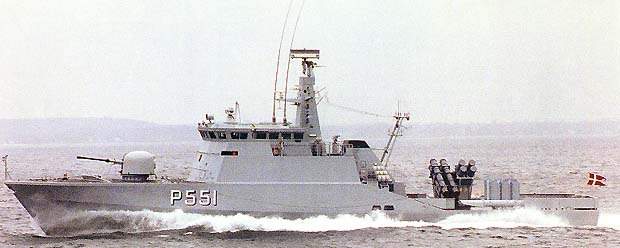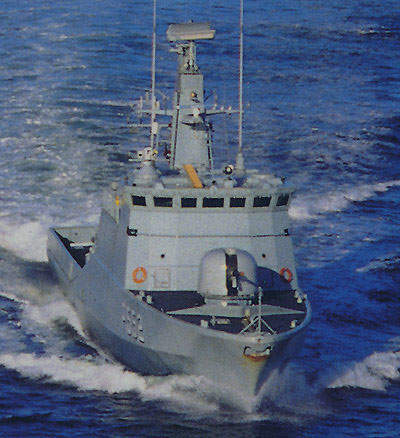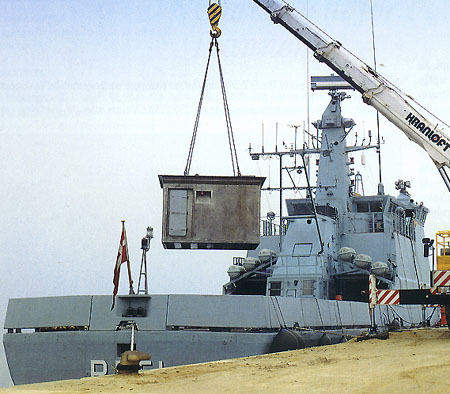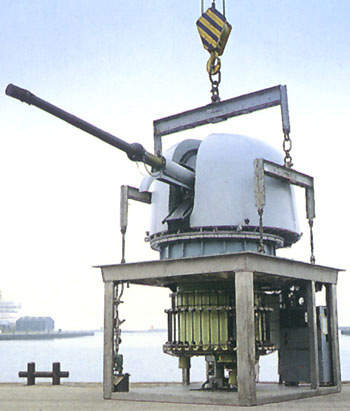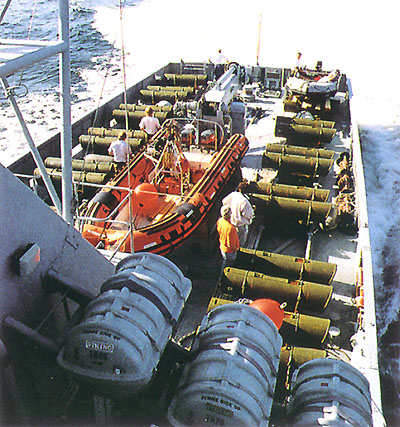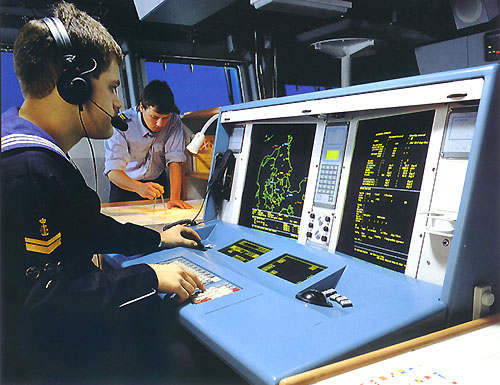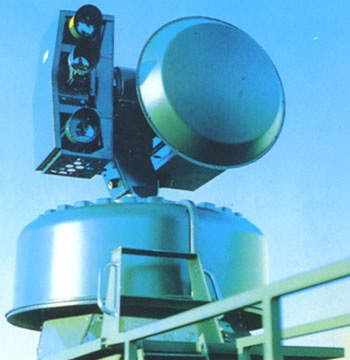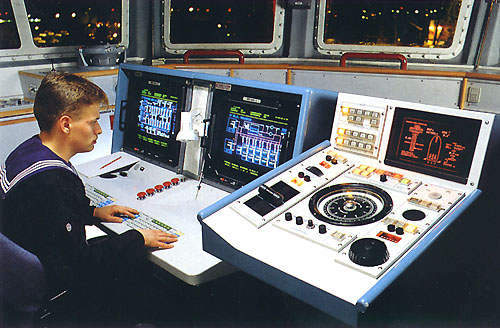The Flyvefisken Class multirole vessels were built for the Royal Danish Navy by the Danish shipyard Danyard A/S between 1987 and 1996. A total of 14 vessels have been built. The first of class, Flyvefisken (P550), was commissioned in 1989.
Also known as Standard Flex 300 (SF300), the Flyvefisken Class is based on a modular concept – using a standard hull with containerised weapon systems and equipment, which allows the vessel to change role quickly for surveillance, surface combat, anti-submarine warfare (ASW), mine countermeasures / minehunter, minelayer or pollution control.
Standard equipment for all roles includes the command system, radars and hull-mounted sonars.
The Danish Navy decided to reduce the Flyvefisken Class to ten vessels in 2005. HDMS Svaerdfisken was scrapped in April 2007. Lithuania placed a contract for two Flyvefisken Class vessels, Flyvefisken (P550) and Lommen (P559), with an option (subsequently exercised) on a third vessel, Hajen (P551). Flyvefisken (P550) was delivered to the Lithuanian Navy in June 2008. Hajen and Lommen were delivered in January 2010. The Royal Danish Navy decommissioned its Flyvefisken fleet in October 2010.
Flyvefisken design
The hull is constructed of an FRP (fibre-reinforced plastic) sandwich with a cellular core between outer and inner FRP laminates. This material reduces weight and maintenance, since it is non-magnetic.
Electro-magnetic compatibility (EMC) in the non-metallic hull is achieved by sprayed layers of zinc and shielding of cable glands and penetrating non-metallic pipes and ducts.
There are four container positions on each vessel. The stainless steel containers, supplied by Monberg and Thorsen, measure 3m × 3.5m × 2.5m. All dedicated electronics or machinery is installed inside the container and connected to standard interface panels.
Command system
The ship’s C3I system, produced by Saab Systems and Terma Elektronik, is a variant of the 9LV mk3 and is based on an Ethernet (IEEE 802.3) databus and a series of nodes with distributed processors. The open architecture allows new weapon systems to be added by creating new nodes. Ada software is used. Between three and six operator’s consoles are required, depending on role.
The Royal Danish Navy has instituted an upgrade programme for the Flyvefisken C3I system. The new system is called C-FLEX; Danish companies Terma and Systematic are responsible for the software element and Maersk Data Defence (formerly Infocom) for the consoles. Maersk is also upgrading the communications suite.
As well as increased functionality and commonality, C-FLEX will integrate the evolved Sea Sparrow missile (ESSM) and Harpoon Block II land attack missile into the combat system. C-FLEX completed system acceptance trials onboard HDMS Lommen and entered service in February 2004. It will be installed on six vessels by 2008, with an option on the remaining eight vessels to follow.
Saab Systems 9LV mk3 radar / optronic fire control system has Ku-band TWT radar tracker, infrared camera, TV camera and laser rangefinder.
Missiles
Boeing Harpoon surface-to-surface missile system is fitted for the surface combat role. Harpoon has an active radar seeker with inertial mid-course guidance, a 220kg warhead and a range of 120km.
Mk48 Nato vertical launch Sea Sparrow surface-to-air missile system from Raytheon is fitted for the surface combat, mine countermeasures and minelayer roles. The mk48 mod 3 launcher (for vessels under 1,000t) has cells for six missiles. SeaSparrow uses semi-active radar guidance and range is 14km.
Gun
For all roles except anti-pollution, the ship carries one 76mm Oto Melara Super Rapid gun which fires 120 rounds a minute and has a range of 16km.
Torpedoes
For surface combat roles, two 533mm torpedo tubes are fitted with Bofors TP613 wire-guided passive homing torpedoes. For ASW roles, anti-submarine torpedoes and depth charge launchers will be carried. Mine rails for 60 bottom mines are fitted for minelaying missions.
Countermeasures
For mine countermeasures / hunting, the ship carries the Thales Underwater Systems (formerly Thomson Marconi Sonar) IBIS 43 data handling system and Thales Underwater Systems 2054 side scan sonars and two remotely controlled mine identification and disposal vehicles. The ship will normally control two above surface drones called surface auxiliary vessels (SAVs), built by Danyard. Each SAV can deploy a 2054 sonar in a towfish to a depth of 200m.
For ESM (electronic support measures) the vessel has the Thales Defence Sabre radar warning system, and for ECM (electronic countermeasures), the Thales Defence Cygnus jammer.
The ships have been upgraded with the Terma DLS decoy launch system which has new computer software, hardware and engagement parameters and fires the Chemring 130mm Chimera radio frequency / infrared (RF/IR) seduction round. The DLS uses the two six-barrel Nato Sea Gnat launchers.
Flyvefisken sensors
The main search radar for the first seven ships of the class is the Selex Sistemi Integrati (formerly Alenia Marconi Systems) AWS-6 2D G-band radar, and for the last seven the EADS Systems & Defence Electronics TRS-3D/16 G-band radar. The TRS-3D/16 provides long-range air surveillance to 200km with volume search mode. Surveillance radar is Terma Scanter Mil E/F and I/J-band radar. Navigation radar is Furuno I-band radar.
Saab Systems CTS 36 hull-mounted active search high-frequency sonar is fitted as standard. Thales Underwater Systems TMS 2640 variable depth sonar is fitted for the ASW role.
Propulsion
Propulsion is combined diesel and gas turbine (CODAG). A General Electric LM500 gas turbine drives a fixed-pitch centre-line propeller, providing 5,450hp. Two MTU 16V 396TB94 diesels each drive a controllable-pitch wing propeller.
Other features include a bow thruster, roll stabilisation system which acts on the wing rudders and complementary tank system. A Lyngso Marine control system manages the propulsion system and machinery.
The Global Naval Surface Combatants and Warfare Systems Market 2011-2021
This project forms part of our recent analysis and forecasts of the global naval surface combatants and warfare systems market available from our business information platform Strategic Defence Intelligence. For more information click here or contact us: EMEA: +44 20 7936 6783; Americas: +1 415 439 4914; Asia Pacific: +61 2 9947 9709 or via email.

